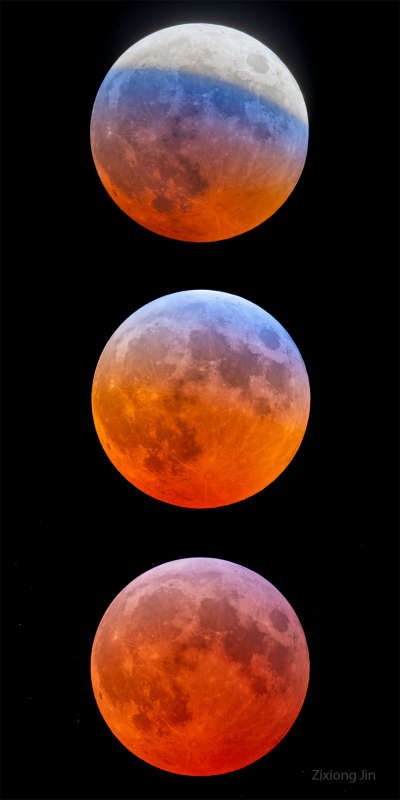Credit & Copyright: Zixiong Jin
Explanation:
What causes a blue band to cross the Moon during a lunar eclipse?
The blue band is real but usually quite hard to see.
The featured HDR image of last week's lunar eclipse, however -- taken from
Norman,
Oklahoma (USA)
-- has been digitally processed to exaggerate
the colors.
The gray color on the upper right of the top lunar image is
the Moon's
natural color, directly illuminated by sunlight.
The lower parts of the Moon on all three images
are not directly lit by the Sun since it is
being eclipsed -- it is in the
Earth's shadow.
It is faintly lit, though, by sunlight that has passed deep through
Earth's atmosphere.
This part of the Moon is red -- and called a
blood Moon -- for the same reason that Earth's sunsets are red:
because air scatters away
more blue light than red.
The unusual purple-blue band visible on the upper right of
the top and middle images is different -- its color is augmented
by sunlight that has passed high through Earth's atmosphere, where
red
light is better absorbed by
ozone than blue.
Celestial Surprise:
What picture did APOD feature on your birthday? (post 1995)
1999 2000 2001 2002 2003 2004 2005 2006 2007 2008 2009 2010 2011 2012 2013 2014 2015 2016 2017 2018 2019 2020 2021 2022 2023 2024 2025 |
Yanvar' Fevral' Mart Aprel' Mai Iyun' Iyul' Avgust Sentyabr' Oktyabr' Noyabr' Dekabr' |
NASA Web Site Statements, Warnings, and Disclaimers
NASA Official: Jay Norris. Specific rights apply.
A service of: LHEA at NASA / GSFC
& Michigan Tech. U.
|
Publikacii s klyuchevymi slovami:
lunar eclipse - lunnoe zatmenie
Publikacii so slovami: lunar eclipse - lunnoe zatmenie | |
Sm. takzhe:
Vse publikacii na tu zhe temu >> | |
